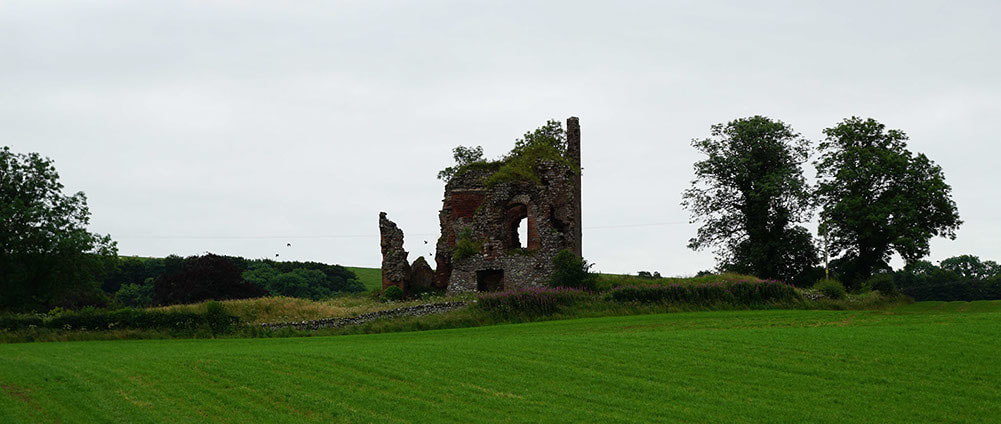 The ruins of Torthorwald Castle The ruins of Torthorwald Castle In the 13th century, Sir Duncan Kirkpatrick became Lord of Torthorwald through his marriage to Isabel Tortherwald. Isabel was the daughter of Sir David Thortherwold. Sir Duncan was the son of Stephen Kirkpatrick, Lord of Closeburn and brother of Sir Roger Kirkpatrick. Sir Roger was my husband's 15th-great grandfather. Sir Duncan is found in several references as fighting alongside his cousin William Wallace in the fight to free Scotland from England rule. The castle is a large ruined rectangular tower at the centre of the village of Torthorwald just outside Dumfries in south west Scotland. The first castle on the site was an earthwork motte-and-bailey built in the 12th century. The following is a detailed history found on the website CastlesFortsBattles.co.uk: Torthorwald Castle was originally an earth and timber motte-and-bailey fortification probably raised in the twelfth century. By the fourteenth century it had been restyled into an enclosure castle and work had started on the large tower that dominates the site today. It ceased to be used as a residence in the seventeenth century. The name Torthorwald derives from 'hill of Thorold' suggesting there may have been a residence and/or fortification before a motte-and-bailey castle was built in the twelfth century. However, the latter is the first confirmed castle and was probably raised by a member of the de Torthorwald family who had taken their name from the site and were the first recorded owners. Their origin is uncertain and, whilst the construction of a motte-and-bailey suggests they may have been Norman or Fleming immigrants, it is also possible they were of native decent and just imitated the latest continental design in castle building that was becoming common place in Scotland at the time.
The original castle was surrounded by substantial earthworks with a high rampart augmented by ditches. An outer bailey, which was divided into two at some point during the castle's occupation, was located to the south and west of the motte. A small burn ran adjacent to the site providing additional defence and a useful water source. By the mid thirteenth century the site was in the hands of Sir David Torthorwald but some of his descendants supported the English cause during the First War of Scottish Independence. At some point after his rebellion of 1306, Robert the Bruce then confiscated the lands and granted them to Sir John de Soulis. After John's death in Ireland in 1318, Torthorwald passed to the Kirkpatrick family. It was possibly Humphrey de Kirkpatrick, [Vicky's Note: It wasn't Humphrey, but Sir Duncan as I stated above] who acquired the lands in 1326 and held them until his death in 1357, who started work on the stone structure that would later evolve into the tower seen today. In 1425 Torthorwald passed to William Carlyle following his marriage to the Kirkpatrick heiress. It was probably he who rebuilt the castle into a trapezoidal shaped enclosure castle with the line of the wall perhaps mirroring the original bailey. A circular tower was built on the south-west corner. At some point the stone structure started by Humphrey de Kirkpatrick evolved into a simple rectangular Tower House and this work was probably also due to William or his son, John. As was the norm, the basement of the tower was a vaulted storeroom. The First Floor hosted the Great Hall and the original entrance to the tower was also on this level. The upper storeys provided the accommodation whilst a turnpike stair, embedded within the thickness of the tower's wall, provided internal access to all levels. In 1544 the castle was embroiled in a family feud when Michael Carlyle sacked the site as part of a dispute with his sister-in-law, Janet. When she complained to the Scottish Government the Regent - James Hamilton, Earl of Arran - supported her case and imposed a legal settlement. Michael Carlyle retained Torthorwald but during the latter decades of the sixteenth century he vied with his half-brother - George Douglas of Parkhead - for ownership of the castle. It ultimately ended up with the Douglas family and the last recorded resident was Archibald Douglas of Dornock who was living there in 1630. The roof was removed in the eighteenth century and thereafter Torthorwald drifted into ruin. Efforts were made in the nineteenth century to stabilise the structure but the north end of the tower collapsed in 1993.
3 Comments
Tracy McNown
12/23/2021 10:24:06 pm
Hello Vicky, I am doing my family genealogy and I am related to a Sir Duncan Kirkpatrick(Laird of Ross). Is this any relation to the Duncan Kirkpatrick in your story? Thanks so much!
Reply
12/24/2021 08:36:53 am
Hi Tracy! I can't give you a definitive answer to that. The books that I used for research can be found on my Kirkpatrick history page at: https://www.seibelfamily.net/kirkpatrick-history.html You can download each book for easy reading to your computer. I downloaded each of them from archive.org They are out of copyright so there are no restrictions. If you find a connection please let us know to add to the story!
Reply
Lucas Patrick
2/17/2024 06:49:38 pm
Sir Duncan is my 18th great grandfather! This is honestly pretty awesome.
Reply
Leave a Reply. |
AuthorMy name is Vicky, and after researching my family history since 1999, I have found amazing stories that need to be told. I hope you enjoy them as much as I have! Archives
May 2023
Categories |

 RSS Feed
RSS Feed